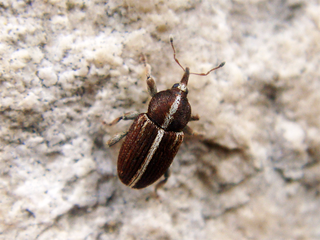
The Curculionidae are a family of weevils, commonly called snout beetles or true weevils. They are one of the largest animal families with 6,800 genera and 83,000 species described worldwide. They are the sister group to the family Brentidae.

Weevils are beetles belonging to the superfamily Curculionoidea, known for their elongated snouts. They are usually small – less than 6 mm in length – and herbivorous. Approximately 97,000 species of weevils are known. They belong to several families, with most of them in the family Curculionidae. It also includes bark beetles, which while morphologically dissimilar to other weevils in lacking the distinctive snout, is a subfamily of Curculionidae. Some other beetles, although not closely related, bear the name "weevil", such as the biscuit weevil, which belongs to the family Ptinidae.

Anthonomus is a genus of weevils. This genus includes major agricultural pests such as the boll weevil, strawberry blossom weevil, and pepper weevil, as well as promising biological pest control agents such as Anthonomus santacruzi.

The beetle subfamily Curculioninae is part of the weevil family Curculionidae. It contains over 23,500 described species in 2,200 genera, and is therefore the largest weevil subfamily. Given that the beetle order (Coleoptera) contains about one-quarter of all known organisms, the Curculioninae represent one of the – if not the – most successful radiations of terrestrial Metazoa.

Sitona is a large genus of weevils in the family Curculionidae native to the Nearctic and Palaearctic regions. Over 100 species have been described. Sitona is easily distinguished from related genera by flat, recumbent scales on the mandibles, by the absence of an oval scar on the mandibles, by short and broad rostrum with a deep, longitudinal, median groove, and by dense scales on the body.

The Entiminae are a large subfamily in the weevil family Curculionidae, containing most of the short-nosed weevils, including such genera as Entimus, Otiorhynchus, Phyllobius, Sitona, and Pachyrrhynchus. In comparison with their stunning diversity, only a few of these weevils are notorious pests of major economic importance. Entimines are commonly encountered in the field, including urban environments, and abundant in entomological collections.

Rhynchophorus, or common name palm weevils, is a genus of beetles in the weevil family, Curculionidae. Palm weevils are major pests of various trees in the family Arecaceae throughout the tropics including: coconut, Areca catechu, species of the genus Phoenix, and Metroxylon sagu. Two species are invasive pests outside their native ranges, Rhynchophorus ferrugineus and Rhynchophorus palmarum.

Eudiagogus is a genus in the beetle family Curculionidae. They are commonly known as sesbania clown weevils, in reference to the fact that they eat plants of the genus Sesbania. There are about five described species in Eudiagogus.

Rhyssomatus is a genus of true weevils in the beetle family Curculionidae. There are at least 180 described species in Rhyssomatus.
Aulobaris is a genus of flower weevils in the beetle family Curculionidae, with about eight described species.
Amotus is a genus of broad-nosed weevils in the beetle family Curculionidae. There are at least three described species in Amotus.
Colecerus is a genus of broad-nosed weevils in the beetle family Curculionidae. There are about nine described species in Colecerus.
Aragnomus is a genus of broad-nosed weevils in the beetle family Curculionidae. There are at least three described species in Aragnomus.
Adaleres is a genus of broad-nosed weevils in the beetle family Curculionidae. There are at least three described species in Adaleres.
Acamptus is a genus of true weevils in the beetle family Curculionidae. There are about nine described species in Acamptus.
Cercopedius is a genus of broad-nosed weevils in the beetle family Curculionidae. There is at least one described species in Cercopedius, C. artemisiae.
Agasphaerops is a genus of broad-nosed weevils in the beetle family Curculionidae. There are at least two described species in Agasphaerops.
Eisonyx is a genus of flower weevils in the beetle family Curculionidae. There are three described species in Eisonyx.
Hesperobaris is a genus of flower weevils in the beetle family Curculionidae, with currently one described species in North America.
Agronus is a genus of broad-nosed weevils in the beetle family Curculionidae. There are at least three described species in Agronus.









